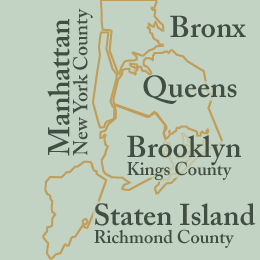Trial
In General
Jury Trials
Testimony of Witnesses
Objections
Trial Decision
After a case has been conferenced in the Personal Appearance Part and discovery, if any, completed, the case will be ready to be tried. The Judge will tell the parties where and when to appear for the trial. At the trial, the parties each get a chance to present their side of the case, and the judge will make a decision and judgment based on the evidence and arguments presented. The parties must have all their witnesses and evidence ready to present at the trial. If you have a good reason for not being ready to try the case, such as a medical reason, or one of your witnesses is out of town, you can ask the Judge for an adjournment. If this becomes necessary you should notify the other side ahead of time by mail that you are going to ask the court for an adjournment.
It is sometimes better to settle a case than to try it. A settlement is a voluntary, binding agreement that resolves the differences between the parties to a lawsuit. If the case is settled, there is no trial. For more information about settling a case, click on Stipulations and Settlements.
If the plaintiff or defendant has properly filed a jury demand and paid the jury demand fee, the case will be tried before a jury. The jury, not the judge, will make the decision and then a judgment will be entered based on the verdict reached by the jury. If the jury is unable to reach a verdict, the Judge will have to declare a mistrial and the case will have to be tried again before a new jury.
A jury trial begins with jury selection. A panel of prospective jurors is called for voir dire. The Court will examine the jurors as to their qualifications. A party is entitled to challenge a juror for cause when a prospective juror is not qualified, such as, is not impartial, is related to one of the parties, or will not follow the law. A party is also entitled to a limited number of peremptory challenges. Six jurors, plus alternates, must be selected to hear the case.
After each side presents testimony and evidence, the judge will deliver a charge to the jury, which sets forth the jury’s responsibility to decide the facts in light of the applicable rules of law.
The plaintiff’s case is presented first. After being sworn as a witness, the plaintiff will tell his or her version of the incident. All relevant papers or other evidence should be presented at this time to be offered in evidence. When the plaintiff has finished testifying, the defendant has the right to ask questions. This is called cross-examination. After a party has cross-examined a witness, the other side has the chance to redirect examination of the witness in order to re-question the witness on points covered during the cross-examination. Sometimes the Judge may ask questions to clarify matters. Other witnesses may be presented in support of the plaintiff’s claims, and they, too can be cross-examined by the defendant and questioned by the Judge.
The defendant may then be sworn and tell his or her side of the story and offer evidence. All papers or other evidence should be presented at this time to be offered in evidence. When the defendant has finished testifying, the plaintiff has the right to cross-examine the defendant. After a party has cross-examined a witness, the other side has the chance to redirect examination of the witness in order to re-question the witness on points covered during the cross-examination. Sometimes a Judge may ask questions to clarify matters. Other witnesses may be presented in support of the defendant’s claims, and they, too, can be cross-examined by the plaintiff and questioned by the Judge. After the presentation of the defendant’s case, the plaintiff has the right to ask the Judge for an opportunity to present evidence to rebut the defendant’s case.
There is a body of law called "rules of evidence." The purpose of these rules is to make sure that evidence is relevant, reliable and authentic. Because of these rules certain testimony or documents may not be legally admissible. For example, an affidavit is not admissible in evidence because its admission would deprive the other side of the right to question the person who wrote it.
Parties to a lawsuit have a right to object to the introduction of evidence or the way a question is being asked or answered. The proper way to object is to say "objection." The Judge may then ask what the basis for the objection is. If the Judge agrees with the objection, the Judge will say "sustained" and the evidence will not be admitted. If the Judge disagrees with the objection, the Judge will say "overruled" and the evidence will be admitted.
When the trial is completed, you may have to wait for the Judge to write a decision. You may contact the court to see if a trial decision has been issued. To find out where to visit or call in your county, click on locations.
If there is a decision in your case, and you are the winning
party, you will want to come to court to have the clerk prepare
and enter a judgment. Click on Entering
Judgments to learn more about this. If you are the losing
party, you may want to appeal.
You may click on Appeals to learn
more.


